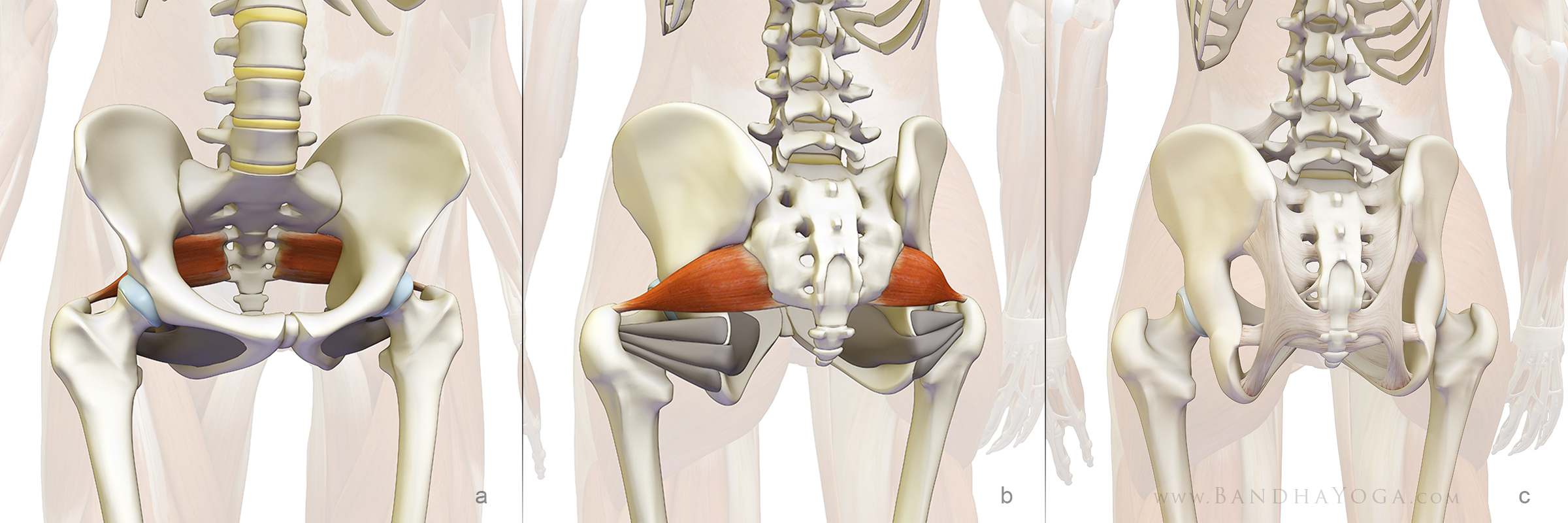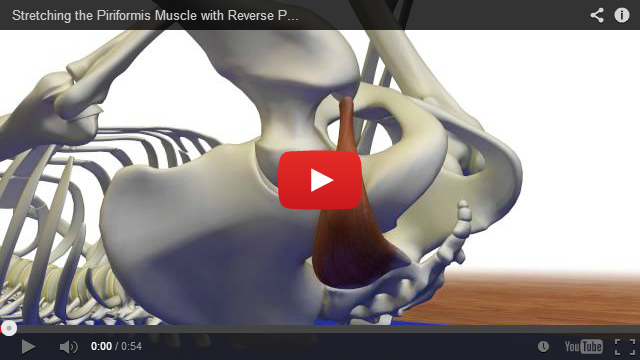If a picture's worth a thousand words, then what is an animated video worth? In this blog post we look beneath the skin to see what happens with the piriformis muscle in Reverse Pigeon Pose and provide an overview of the muscle, its attachments and action, and its role in stabilizing the sacroiliac joint. We also examine the use of joint rhythm to optimize the stretch.
The piriformis muscle originates on the anterior (front) surface of the sacrum and inserts onto the greater trochanter of the femur (thigh bone). Figures 1 (a) and 1 (b) are front and back views of the piriformis muscle. Figure 1 (c) illustrates the stout ligamentous stabilizers of the sacroiliac joint.
 |
| Figures 1 (a) is a front view of the piriformis, (b) is a back view and (c) illustrates the ligaments that stabilize the sacroiliac joint. (click on image to enlarge) |
Note that the piriformis is a muscular stabilizer of the sacroiliac joint. Imbalances between the piriformis muscles can contribute to subtle asymmetries within the pelvis, which can then be transmitted to the vertebral column. This underscores the importance of achieving a balanced stretch between the two sides when working with this muscle in yoga. Learn more about the stabilizers of the sacroiliac joint and lumbar spine in our post on the thoracolumbar fascia. We discuss the details of the static and dynamic stabilizers of the joints in The Key Muscles and Key Poses of Yoga.
To understand why Reverse Pigeon Pose works to stretch the piriformis we need to know that the actions of this particular muscle vary according to the position of the hip joint. For example, when the hip is in a neutral position, the piriformis acts to externally rotate (turn outward), flex and abduct the hip joint. When the hip is flexed beyond about 60 degrees the piriformis becomes an internal rotator and extensor (and remains an abductor). Muscles stretch when we move a joint in the opposite direction of the action of the muscle. In Reverse Pigeon Pose, the hip is flexed and externally rotated, thus stretching the muscle (which extends and internally rotates the hip in this position). This video illustrates the stretch (click on image to open in a separate window).
When viewing the video, note how flattening the back moves the origin of the piriformis on the sacrum further away from its insertion on the femur, thus accentuating and refining the stretch. This is an example of lumbar-pelvic and femoral-pelvic rhythm. The last section of the video, where we have digitally hidden one half of the pelvis to expose the movement of the sacrum, illustrates this concept. Learn more about joint rhythm in our post “Preventative Strategies for Lower Back Strains in Yoga.”
Figure 2 illustrates some variations for this stretch. Figure 2 (a) is the classic stretch that is typically utilized in yoga. Figure 2 (b) is a modification for persons that cannot practice the full stretch. This variation is also useful to experience the effect of flattening the lumbar in the pose. Figure 2 (c) stretches the piriformis of the lower side leg by adducting and internally rotating the femur. Figure 2 (d) adducts (draws toward the midline) the upper side leg, thus opposing the action of the piriformis for abducting the femur. Figure 2 (e) illustrates a variation commonly employed in physical therapy as part of the regimen for Piriformis Syndrome, a condition that can cause sciatica (we cover this condition in an upcoming post). In this variation, the upper leg crosses all the way over, thus adducting the femur and stretching the muscle. This is a good alternative for those who experience knee issues in the classic stretch. Our next post illustrates a technique for protecting the knee in Reverse Pigeon Pose (and similar asanas).
I typically do several 20-30 second stretches on each side, easing into and out of the pose. We explain the rationale for this length of time in a pose in the blog post on Hanumanasana (front splits). If you experience pain in this (or any) stretch, carefully come out of the pose. Folks with sciatic type pain should consult a health care practitioner who is appropriately trained and qualified to diagnose and manage such conditions. Follow their guidance, working with yoga as an adjunct in prevention and treatment (where appropriate).
If you would like to learn more about combining modern Western science with the ancient art of yoga, please join us for a week in paradise at Blue Spirit Costa Rica for our second annual intensive on anatomy, biomechanics and therapeutics for Hatha yoga. I will be teaching state of the art techniques on these subjects, including much new material relating to therapeutic applications of yoga--all with great 3-D illustrations, excellent food, beautiful facilities and expertly taught daily Hatha yoga classes. We encourage you to register soon, as this workshop is nearly full.
Thanks for stopping by. Stay tuned for our next post on protecting the knee in poses like Reverse Pigeon. We also greatly appreciate when you share our posts on Facebook, Twitter and Google Plus.
Namaste'
Ray and Chris
Thanks for stopping by. Stay tuned for our next post on protecting the knee in poses like Reverse Pigeon. We also greatly appreciate when you share our posts on Facebook, Twitter and Google Plus.
Namaste'
Ray and Chris

